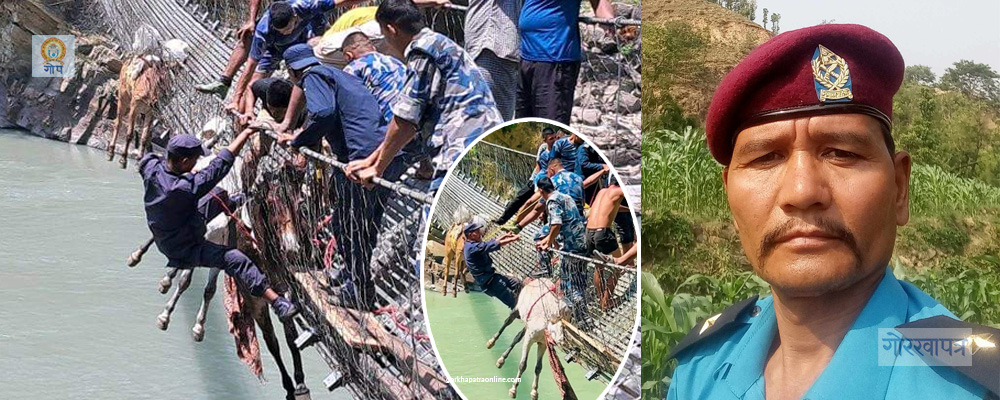
By Ramesh Bahadur Rawat,Achham, June 13: The news and photographs about the mules being trapped on the suspension bridge over the Karnali River went viral across the country last week.
Thirteen mules from Kalekada in Panchdewal Binayak Municipality-9, Achham, were on their way to Khidkijyula in Aaathbiskot Municipality-4, Dailekh, to fetch food supplies. But unfortunately, the main cable of the bridge snapped, trapping them over the mighty Karnali. It took about five hours to rescue the trapped mules, and two of them died.
Various sectors made efforts to rescue the mules. Chief District Officer of Achham, Shiva Prasad Lamsal, and Achham’s Police Chief and DSP Santosh Pathak arrived at the scene to assist the rescue work.
Panchdewal Binayak Municipality deployed all its available resources. Deputy Mayor Harka Bahadur Rawal and Chief Administrative Officer Dhruva Prasad Sapkota reached the site as soon as they received the news of the accident.
Security personnel from the Armed Police Force and residents from Achham and Dailekh actively participated in the rescue operation.
For everyone getting involved in the incident was unprecedented. Ward Chairman Ram Prasad Jaisi, who was the first to arrive at the scene, tried all possible means to save the mules. However, it was extremely difficult to figure out a way to rescue the poor animals.
On the one hand, it was an incident never experienced, and it was highly risky for people to use the bridge for rescue works on the other.
The frantic movements of the 13 poor mules fighting for their life on the bridge were added challenges. Initially, the workers who were building another new suspension bridge nearby offered to help but demanded Rs. 10,000 per mule. At the time, Panchdewal Binayak Municipality Mayor Ambika Chalise was in Surkhet for a programme. Over the phone, Mayor Chalise assured that the municipality would pay the money if the mules were rescued. Despite their efforts, the workers could not complete the rescue.
Assistant Sub-Inspector (ASI) of Nepal Police Ram Singh Pharal from Kalekada Police Station, who was trying to initiate the rescue work immediately after the mules were trapped, was not getting any idea to save the mules.
When he was touched by the mules’ distress, ASI Pharal decided to climb on the bridge himself. He asked for a wire-cutting machine from the market. With only a rope tied around his waist, he began cutting the three wires that had stuck the mules in the middle of the bridge. The first mule fell into the river, swam to the shore, and was safe.
Pharal, taking additional risk, continued to cut other iron nets that trapped the mules on the bridge.
His colleagues and the Armed Police Force nearby advised him not to take such a big risk, but he was determined not to let the mules die in front of him. He quickly cut the wires, and the mules began to fall into the river one after another.
Locals Krishna Majhi, Mahendra Majhi, and Prem Majhi, using boats, helped the mules reach the riverbank.
Out of the 10 mules that dropped into the river, eight survived, while two died upon falling. The remaining three mules were rescued by pulling them up as they were likely to fall onto the boats below.
The bravery displayed by ASI Pharal during the rescue was praised by many of the people present there. However, Pharal did not risk his life for praise. A video footage of Pharal cutting wires while being directly under the mules went viral on a social media. If a mule had fallen from above at that time, his life could have been in danger.
How Pharal made it possible?
In the morning, he received a report that a mule had got stuck. At that time, he was sitting at the table, having washed his hands, and getting ready to have his lunch. Initially, a local had informed the police station that a mule had got stuck. Sub-Inspector Pharal went to check, thinking it may be just one mule.
But he saw more than a dozen mules struggling on the bridge when he looked at the bridge from Chandika Secondary School. When he reached the bridge and saw the condition of the mules, tears filled his eyes, and he immediately informed his seniors.
People began gathering. Sub-Inspector Pharal called all the police officers and discussed if anything could be done. However, without equipment and training, nothing could be done.
He gathered all the materials available locally that could be used for rescue. Despite his efforts, the situation didn’t improve. With no other options left, he took iron-cutting scissors to cut the wires, instructed the Armed Police Force personnel to stay behind, and climbed onto the bridge himself. He did everything he could and managed to save the mules.
Pharal said that the training he received during the emergency period in the armed insurgency in the country helped him in the rescue.
Pharal is one of the oldest policemen to get enrolled in the police. He was recruited into the police force in 2001 during the height of the Maoist armed conflict.
The training he received to survive at that time helped him rescue the mules.
Pharal, who hails from Mahakali Municipality-2 in Darchula, didn’t feel hungry until the mules were rescued. He worked the entire day without eating. He said that during the conflict, they survived for two days with just one packet of noodles. The habit of enduring hunger comes from that time.












